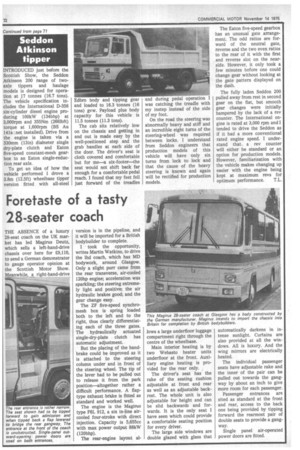Seddon Atkinson tipper
Page 74

If you've noticed an error in this article please click here to report it so we can fix it.
INTRODUCED just before the Scottish Show, the Seddon Atkinson 200 range of twoaxle tippers and haulage models is designed for operation at 17 tonnes (16.7 tons). The vehicle specification includes the International D-358 six-cylinder diesel engine producing 100kW (I34bhp) at 3,000rpm and 355Nm (2661bft) torque at 1,600rpm (BS Au 141a: net installed). Drive from the engine is taken via a 330rnm (13in) diameter single dry-plate clutch and Eaton five-speed constant-mesh gearbox to an Eaton single-reduction rear axle.
To get an idea of how the vehicle performed I drove a 3.8m (12.5ft) wheelbase tipper version fitted with all-steel Edbro body and tipping gear and loaded to 16.3 tonnes (16 tons) gvw. Payload plus body capacity for this vehicle is 11.5 tonnes (11.3 tons).
The cab sits relatively low on the chassis and getting in and out is made easy by the well-positioned step and the grab handles at each side of the door. The driver's seat is cloth covered and comfortable but for me—a six-footer—the seat would not shift back far enough for a comfortable pedal reach. I found that my feet fell just forward of the treadles and during pedal operation I was catching the treadle with my instep instead of the side of my foot.
On the road the steering was abnormally heavy and stiff and an incredible eight turns of the steering-wheel was required between locks. I understand from Seddon engineers that production models of this vehicle will have only six turns from lock to lock and that the cause of the heavy steering is known and again will be rectified for production models. The Eaton five-speed gearbox has an unusual gate arrangement. The odd ratios are forward of the neutral gate, reverse and the two even ratios to the rear of it with the first . and reverse slot on the nearside. However, it only took a few minutes before one could change gear without looking at the gate pattern displayed on the dash.
The fully laden Seddon 200 pulled away from rest in second gear on the flat, but smooth gear changes were initially hampered by the lack of a rev counter. The International engine is rated at 3,000 rpm and I tended to drive the Seddon as if it had a more conventional rated engine speed. I understand that a rev counter will either be standard or an option for production models. However, familiarisation with the vehicle makes changing up easier with the engine being kept at maximum revs for optimum performance. T.L.




























































































































